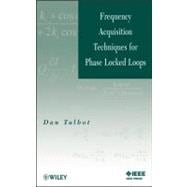
What is included with this book?
DANIEL B. TALBOT currently runs a product development business specializing in RF/analog engineering. He has years of industry experience as a chief technical engineer at DBX Corporation, LTX Corporation, and a principal or research engineer or equivalent at Raytheon, RCA David Sarnoff Labs, General Instrument, and several other aerospace and commercial electronics firms; has been granted eight U.S. patents in the field of RF/analog/fiber optic engineering; and is an elected Fellow of the Audio Engineering Society and a Life Member of the IEEE.
1 Introduction 1
2 A Review of PLL Fundamentals 3
2.1 What is a PLL?, 3
2.2 Second-Order PLL, 7
2.3 Second-Order PLL Type One, 7
2.4 Second-Order PLL Type Two, 7
2.5 Higher-Order PLL’s, 8
2.6 Disturbances, 8
2.7 Frequency Steering and Capture, 9
2.8 Effect of DC Offsets or Noise Prior to the Loop Filter, 10
2.9 Injection-Locked Oscillations, 15
3 Simulating the PLL Linear Operation Mode 17
3.1 Linear Model, 17
3.2 A Word About Damping, 19
4 Sideband Suppression Filtering 21
4.1 Reference Sidebands and VCO Pushing, 21
4.2 Superiority of the Cauer (or Elliptical) Filter, 22
5 Pros and Cons of Sampled Data Phase Detection 25
5.1 What are the Forms of Sampled Data Phase Detectors?, 25
5.2 A. Ramp and Sample Analog Phase Detector, 25
5.3 B. The RF Sampling Phase Detector, 28
5.4 C. Edge-Triggered S-R Flip-Flop, 29
5.5 D. Edge-Triggered Flip-Flop Ensemble, 31
5.6 E. Sample and Hold as a Phase Detector, 31
6 Phase Compression 33
7 Hard Limiting of a Signal Plus Noise 35
8 Phase Noise and Other Spurious Interferers 39
8.1 The Mechanism for Phase Noise in an Oscillator, 42
8.2 Additive Noise in an FM Channel and the Bowtie, 42
8.3 Importance of FM Theory to Frequency Acquisition, 45
9 Impulse Modulation and Noise Aliasing 47
9.1 Impulse Train Spectrum, 47
9.2 Sampling Phase Detector Noise, 47
9.3 Spur Aliasing, 50
10 Time and Phase Jitter, Heterodyning, and Multiplication 53
10.1 Heterodyning and Resulting Time Jitter, 53
10.2 Frequency Multiplication and Angle Modulation Index, 54
10.3 Frequency Multiplication’s Role in Carrier Recovery, 54
11 Carrier Recovery Applications and Acquisition 57
11.1 Frequency Multiplier Carrier Recovery in General, 57
11.2 The Simplest Form of Costas PLL, 59
11.3 Higher Level Quadrature Demodulation Costas PLL, 61
11.4 False Lock in BPSK Costas PLL, 62
11.5 Additional Measures for Prevention of False Locking, 65
11.6 False Lock Prevention Using DC Offset, 72
12 Notes on Sweep Methods 73
12.1 Sweep Waveform Superimposed Directly on VCO Input, 73
12.2 Maximum Sweep Rate (Acceleration), 74
12.3 False Lock due to High-Order Filtering, 77
12.4 Sweep Waveform Applied Directly to PLL Loop Integrator, 79
12.5 Self-Sweeping PLL, 79
13 Nonsweep Acquisition Methods 85
13.1 Delay Line Frequency Discriminator, 85
13.2 The Fully Unbalanced Quadricorrelator, 87
13.3 The Fully Balanced Quadricorrelator, 88
13.4 The Multipulse Balanced Quadricorrelator, 89
13.5 Conclusion Regarding Pulsed Frequency Detection, 91
13.6 Quadricorrelator Linearity, 92
13.7 Limiter Asymmetry due to DC Offset, 97
13.8 Taylor Series Demonstrates Second-Order-Caused DC Offset, 100
13.9 Third-Order Intermodulation Distortion and Taylor Series, 101
14 AM Rejection in Frequency Detection Schemes 105
14.1 AM Rejection with Limiter and Interferer, 105
14.2 AM Rejection of the Balanced Limiter/Quadricorrelator Versus the Limiter/Discriminator in the Presence of a Single Spur, 106
14.3 Impairment due to Filter Response Tilt (Asymmetry), 110
14.4 Bandpass Filter Geometric and Arithmetic Symmetry, 114
14.5 Comments on Degree of Scrutiny, 117
15 Interfacing the Frequency Discriminator to the PLL 119
15.1 Continuous Connection: Pros and Cons, 119
15.2 Connection to PLL via a Dead Band, 120
15.3 Switched Connection, 121
16 Actual Frequency Discriminator Implementations 125
16.1 Quadricorrelator, Low-Frequency Implementation, 125
16.2 Frequency Ratio Calculating Circuit for Wide-Bandwidth Use, 128
16.3 Dividing the Frequency and Resultant Implementation, 131
16.4 Marriage of Both Frequency and Phaselock Loops, 135
16.5 Comments on Spurs’ Numerical Influence on the VCO, 141
16.6 Frequency Compression, 143
17 Clock Recovery Using a PLL 145
17.1 PLL Only, 145
17.2 PLL with Sideband Crystal Filter(s), 152
17.3 PLL with Sideband Cavity Filter, 153
17.4 The Hogge Phase Detector, 161
17.5 Bang–Bang Phase Detectors, 162
18 Frequency Synthesis Applications 165
18.1 Direct Frequency Synthesis with Wadley Loop, 166
18.2 Indirect Frequency Synthesis with PLLs, 173
18.3 Simple Frequency Acquisition Improvement for a PLL, 175
18.4 Hybrid Frequency Synthesis with DDS and PLL, 176
18.5 Phase Noise Considerations, 181
18.6 Pros and Cons of DDS-Augmented Synthesis, 185
18.7 Multiple Loops, 185
18.8 Reference Signal Considerations and Filtering, 186
18.9 SNR of Various Phase Detectors, 187
18.10 Phase Detector Dead Band (Dead Zone) and Remediation, 187
18.11 Sideband Energy due to DC Offset Following Phase Detector, 191
18.12 Brute Force PLL Frequency Acquisition via Speedup, 193
18.13 Short-Term and Long-Term Settling, 193
18.14 N-over-M Synthesis, 193
19 Injection Pulling of Multiple VCO’s as in a Serdes 195
19.1 Allowable Coupling Between any Two VCOs Versus Q and BW, 195
19.2 Topology Suggestion for Eliminating the Injection Pulling, 195
20 Digital PLL Example 199
21 Conclusion 203
References 205
Index 209
The New copy of this book will include any supplemental materials advertised. Please check the title of the book to determine if it should include any access cards, study guides, lab manuals, CDs, etc.
The Used, Rental and eBook copies of this book are not guaranteed to include any supplemental materials. Typically, only the book itself is included. This is true even if the title states it includes any access cards, study guides, lab manuals, CDs, etc.